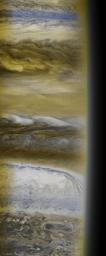
|
Atmospheric Structure
- Click the image above for a larger view
- Full-Res JPEG (761 x 1843) (147.7 kB)
- Full-Res TIFF (761 x 1843) (4.2 MB)
Caption:
This is a composite of several images taken in several colors by the New Horizons Multispectral Visual Imaging Camera, or MVIC. It illustrates the remarkable diversity of structures in Jupiter's atmosphere, in colors similar to what someone "riding" on New Horizons would see. It was taken near the terminator, the boundary between day and night, and shows relatively small-scale, turbulent, whirlpool-like structures near the south pole of the planet. The dark "holes" in this region are actually places where there is very little cloud cover, so sunlight is not reflected back to the camera. Moving toward the equator, the atmospheric structures become more elongated in an east-west direction, taking on the familiar pattern of dark "belts" and light "zones." At the equator itself, a herringbone pattern of clouds known as "mesoscale waves" is apparent, especially near the edge of the terminator where the glancing angle of sunlight emphasizes the alternating dark and light North-South stripes. The energy to form these waves comes from deeper in Jupiter's atmosphere.
This picture provides a vivid illustration that Jupiter's atmosphere has more color contrast than any other atmosphere in the solar system, including Earth's. Data obtained from these and other New Horizons images taken during the encounter will provide valuable insight into the processes occurring on this gas giant.
Cataloging Keywords:
| Name | Value | Additional Values |
|---|---|---|
| Target | Jupiter | |
| System | Jupiter | |
| Target Type | Planet | |
| Mission | New Horizons | |
| Instrument Host | New Horizons | |
| Host Type | Flyby Spacecraft | |
| Instrument | Multispectral Visible Imaging Camera (MVIC) | |
| Detector | ||
| Extra Keywords | Atmosphere, Color | |
| Acquisition Date | ||
| Release Date | 2007-10-09 | |
| Date in Caption | ||
| Image Credit | NASA/Johns Hopkins University Applied Physics Laboratory/Southwest Research Institute | |
| Source | photojournal.jpl.nasa.gov/catalog/PIA10098 | |
| Identifier | PIA10098 | |
